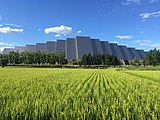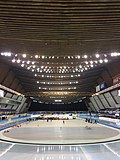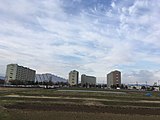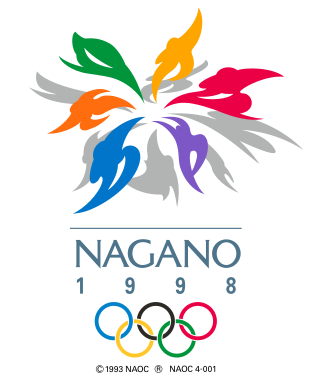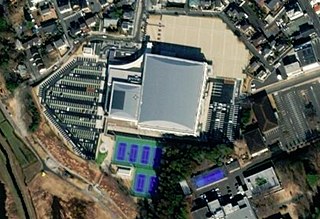- M-Wave north exterior in winter
- M-Wave south exterior in summer
- View of M-Wave from the southwest corner, its shape reflecting the surrounding mountains
- Nagano Olympic logo above the M-Wave south entrance
- M-Wave northeast corner in winter
- M-Wave interior with the ice hockey rink inside the oval in the background
- The Media Village, now Asahi Danchi, with M-Wave in the background
- The M-Wave
長野市オリンピック記念アリーナ | |
M-Wave | |
 M-Wave, inside | |
 | |
| Location | 195 Oaza-Kita-Nagaike, Nagano, Nagano, Japan |
|---|---|
| Coordinates | 36°38′26″N138°14′25″E / 36.64056°N 138.24028°E |
| Public transit | Nagaden Bus, No. 8 Suzaka-Yashima Line, Watauchi-Yashima Line [1] |
| Owner | Nagano City |
| Operator | M-Wave Corporation [2] |
| Capacity | 20,000 [3] (10,000 seats) [4] |
| Field size | 76,100 m2 |
| Surface | ice |
| Construction | |
| Broke ground | 1994 |
| Opened | 1996 |
| Construction cost | ¥384 billion [5] |
| Main contractors | Kume Sekkei, [6] Kajima, [7] Okumura, [8] Nissan Rinkai Construction, [9] Iijima Construction, [10] Takagi Construction [11] |
| Website | |
| Nagano Olympic Memorial Arena M-Wave | |
Nagano Olympic Memorial Arena (長野市オリンピック記念アリーナ, Nagano-shi Orinpikku Kinen Ari-na), or M-Wave (エムウェーブ, emu-ue-bu), is a covered speed skating oval in the city of Nagano, Japan. M-Wave, which opened in November, 1996, was constructed for the speed skating events at the 1998 Winter Olympics. It was Japan's first International Skating Union (ISU) standard indoor 400m double-track, [12] and only second indoor track speed skating in Japan. The other, Meiji Hokkaido-Tokachi Oval, is located in Obihiro, Hokkaido.
Contents
- History
- Speed Skating Championship Events
- 1997 World Allround Speed Skating Championships
- 1998 Winter Olympics
- 1998 Winter Paralympics
- 1999 Asian Speed Skating Championships
- World Single Distances Speed Skating Championships
- World Sprint Speed Skating Championships
- All Japan Speed Skating Distance Championships
- ISU Speed Skating World Cup
- Other Championship Events
- 2002 World Figure Skating Championships
- 2005 Special Olympics World Winter Games
- General Usage of the Arena
- Public Skating
- Nagano Olympic Commemorative Marathon
- Access
- Public Transportation
- Intercity Bus
- Car
- Roads
- Surrounding area
- Gallery
- Track records
- See also
- References
- External links
In addition to the 1998 Winter Olympics and Paralympics, the 2002 World Figure Skating Championships, various ISU world speed skating championships and speed skating world cups, and the 2005 Special Winter Olympics were held.Outside the winter business, other sporting events, large-scale exhibitions and concerts are held.
M-Wave is located in the eastern sections of Nagano City, in the communities of Asahi (朝陽) and Mamejima (大豆島), near the Chikuma River and the city of Suzaka (須坂). M-Wave is located within short distance of four other venues of the 1998 Winter Olympics. It is 3 kilometers from the Aqua Wing Arena, which hosted ice hockey; 5 kilometers from Big Hat, which also hosted ice hockey; 6 kilometers from White Ring (arena), which hosted the figure skating and short track speed skating events; and 11 kilometers from Nagano Olympic Stadium, which was used for the opening and closing ceremonies.
The skating rink operates from October to March, with the 400-m speed skating oval and a regulation-size ice hockey rink inside the oval. [13]
M-Wave was constructed at a cost of 348 billion yen [14] as a speed skating venue for the 1998 Winter Olympics. [15] The building's name, M-Wave comes from its distinct shape which is designed to resemble the surrounding mountains. [16] The building, which was the recipient of the Special Award by the British Institution of Structural Engineers, is one of the largest hanging wooden roof structures in the world. [17] The arena has a capacity of 18,000. The M-Wave is equipped with movable stands and an automatically winding artificial lawn machine. The two movable stands, each of which have seating for 1,210 spectators, allow the arena to be converted into various configurations including concert hall or a football field.

